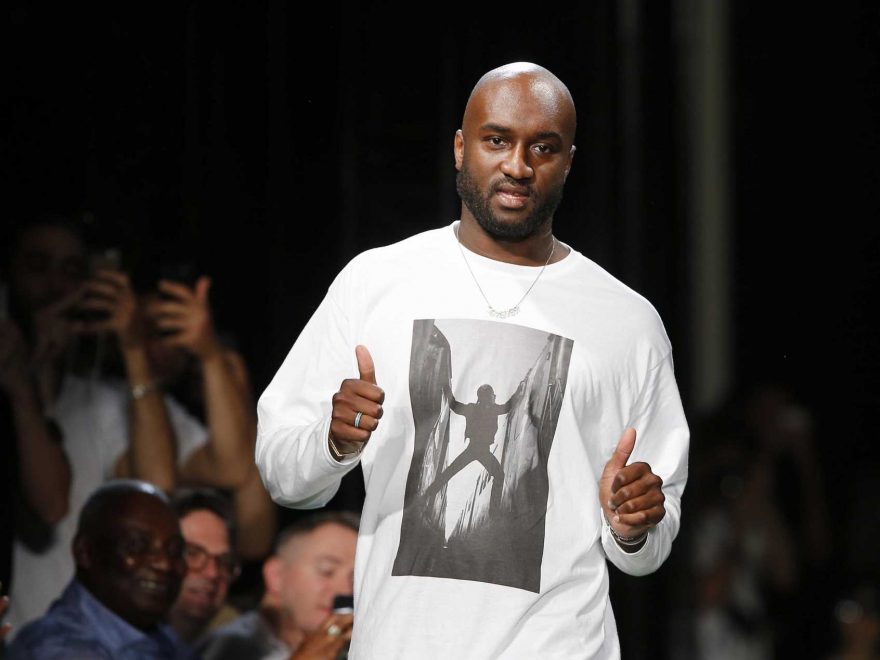Just over a year before he died on Sunday at age 41, Virgil Abloh spoke to Rolling Stone about his love for music, and about the impact and legacy that he hoped his work have.
The designer spoke to Rolling Stone in October 2020 on the occasion of his Louis Vuitton Spring 2021 menswear show in Shanghai, which was soundtracked by South Korean indie band Hyukoh, and featured a surprise pre-recorded set from Lauryn Hill. For Abloh, who grew up “digging in the parents’ record collection” to find new music to listen to, the auditory experience of his fashion shows have always been as important to him as the clothing he’s sending down the runway.
“When you talk about fashion and a runway show, you almost have to be like a DJ studying and spending 10,000 hours in the club, because you have a very narrow hole to thread through,” the designer explained. “You have to take an audience with different musical knowledge, and you have to look at the collection, then you have to look at the location [of the fashion show] and you have to say, ‘What’s going to enhance this experience?’ And so, it takes a lot of thinking to find the songs that a group of people can can gel to.”
Abloh grew up with a diverse range of musical influences, something he credited to his artistic parents (his father worked at a paint shop while his mother was a seamstress, and said to be the one who taught him how to sew). “My dad’s [record] collection was music from James Brown to Fela [Kuti] to Miles Davis,” he recalled, adding that the family listened to everything from “pop and contemporary” to “hard rock and soul music.”
As he made enough money to buy his own albums — by that point on CD — Abloh’s own collection had everything from “Elvis and N.W.A.,” to “Mobb Deep, Wu-Tang and Guns N’ Roses,” he said. His first CD purchase: “the Fresh Prince’s second album” (He’s the DJ, I’m the Rapper, with DJ Jazzy Jeff, released in 1988).
Last June, Abloh made headlines in the middle of the Black Lives Matter movement, after comments he made that appeared to criticize looting that was reported in the wake of the George Floyd death. The designer subsequently issued an apology, saying, “I apologize that it seemed like my concern for those stores outweighed my concern for our right to protest injustice and express our anger and rage in this moment.”
When Abloh spoke to Rolling Stone in October, the designer said it was a reminder that he is a public figure with a large platform. “That was the biggest shock [to me] of 2020,” he said, calling it “part of my learning process.”
“When I say something, people look at it different than a regular human being, and I don’t see myself any different than a regular person,” he offered. “But you know, I’m learning about that responsibility.”
Louis Vuitton
As the American-born son of Ghanaian immigrant parents, Abloh said the Black Lives Matter movement affected him more than he first realized, and he vowed to use his art and influence to shine a light on the Black community.
“That’s sort of like in my DNA to tell this Black experience and to showcase what diversity looks like,” he told Rolling Stone, referencing the Louis Vuitton show in Shanghai, which drew inspiration from African prints and tailoring, mixed with European suiting and streetwear-inspired fits. “This show is proof that when you let a non-typical designer into the space, that all of a sudden you have a different voice, you have a different expression, you have different music, you have different community, you know?” he said. “I like to think of what I do as more community building.”
“Ultimately, I take pride in being a Black designer, and my goal is to open the door for more Black designers and people of color, women of color, so that in a year’s time or multiple years’ time, they don’t have to mention that they’re a Black designer,” he said.
The designer had also been thinking about contributions to the fashion industry when he spoke to Rolling Stone last year.
“So often we think of these institutions as unchangeable, especially [when it comes to] racism,” he said. “And I think that in real time, what my practice is about, is sort of showing that in a lifetime, things can actually change. Like if you would have told the 17-year-old version of myself that not only would there be a Black designer who didn’t go to fashion school, but he would be the head of the most, the longest, oldest, biggest Parisian fashion house, I might have told you that that would have been impossible. I want people to see and draw metaphors between what I may be doing and what they’re doing,” he continued, “to see that things can be changed. It can be it can be transformed in our lifetime.”
“So I stand on that and I put that into my art, and that’s my way of waking up every day, to feel like I’m doing something to advance the world or document the world so people can look at themselves in the mirror and feel what’s going on,” he said. “The feeling right now is that the world is moldable and it’s malleable; the world is like clay.”
Source: Read Full Article

